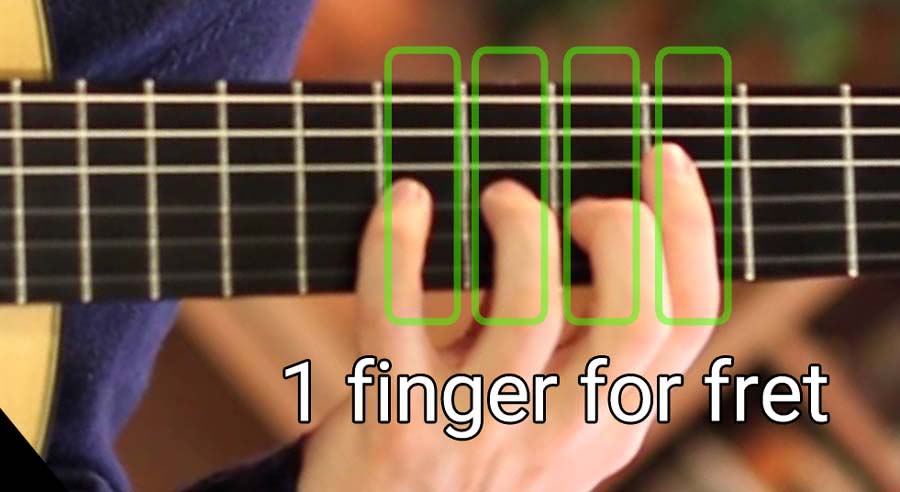D Major Scale On Guitar
How to play the D major scale all along the fretboard

In this tutorial, we are going to learn how to play the D major scale on the guitar. No music theory knowledge is required, this lesson is self-contained and will help beginner guitar players understand the structure and the notes contained in the D major scale, one of the most common guitar scales .
The Notes Of The D Major Scale
Let's first define what is a major scale: it's a sequence of notes that follows this precise structure: root , 1 whole-step , 1 whole-step , 1 half-step , 1 whole-step , 1 whole-step , 1 whole-step and 1 half-step ( R-W-W-H-W-W-W-H ). Here below you find a diagram that clearly shows this structure:
The root of the scale (the starting note of our scale), is the note that gives the name to the scale. Then, in case of a C major scale, the root is the C; in case of a D major scale, what's the root? the D , of course. Obviously, there exists a great number of other scales , that have their own structure, but in this lesson we'll focus only on the major scale,
Whole-Steps and Half-Steps
What are exactly whole-steps and half-steps ? Well, basically they are distances between two notes. On the guitar, 1 whole-step corresponds to a distance of 2 frets , while 1 half-step corresponds to a distance of 1 fret . In some books you can find distances called tones and semitones . 1 tone is equal to 1 whole-step, while 1 semitone is equal to 1 half-step.

D major scale shown on 1 single string - notice the whole-steps/half-steps structure
Playing the D Major Scale on the fretboard
On the diagrams above we have just seen a scale pattern with all the notes on one single string. Even if this pattern is right, it's also inefficient as we have to move our hand up and down the neck the get the note. On the guitar, we have different options, as the same note exists on different strings (unlike the piano keyboard, on which the notes/keys are placed one after the other).
These scale diagrams have been created with our free Guitar Scale Generator
D Major Scale Guitar Patterns
Here below you find the common patterns used to play the D major scale. You have to play the notes inside the yellow boxes.
Guitar pattern from fret 2

Guitar scale pattern from fret 4

Guitar scale pattern from fret 6

Guitar scale pattern from fret 9

How To Play Scales On Guitar
Here's some important tips for playing the scales in the most effective way:
- Follow the rule: 1 fret - 1 finger . If you look carefully at the patterns inside the yellow boxes, you'll notice that they span for 4/5 frets . This allows us to use the index finger for the first fret of the pattern, the middle finger for the second fret, the ring finger for the third fret, and the pinkie for the fourth fret. This minimizes the movements of the left hand and permits to acquire speed and accuracy .
- Play 1 fret at time . You want to play a scale (instead of a chord), so you should play 1 fret at time . Press the fret corresponding the note of the scale, and try to keep the other strings muted (you can use your right hand and the fingers of the left hand that are not pressing frets)
- Play slow and use a metronome . At the beginning, we should practice to improve accuracy and precision of the movements . Speed will come with time. It's mandatory to use a metronome; as first exercise, play the scale up and down, 1 note for beat. Little by little increase the BPM speed, but only if you are able to play comfortably at the current speed.

The D Major Scale On Guitar: Where To Go Next
We have just scratched the surface of the marvelous world of guitar scales . There are many things to know if you want to master lead guitar and soloing, but this introduction lesson should have given you the basics for exploring more advanced topics, such as alternate picking , guitar scales exercises for dexterity and speed, arpeggios and so forth. Here are some useful links for your lead guitar learning path, enjoy!
- 84 Guitar Scales Pattern Pdf Ebook
- Like the scales diagrams on this page? Create yours with this tool: Online Scales Finder
- Guitar Soloing Lesson Series
- The Minor Pentatonic Scale Video Lesson
If you have any questions or comments, drop a comment below. Also, if you liked this lessons, if would be great if you share it with your friends. Thanks!